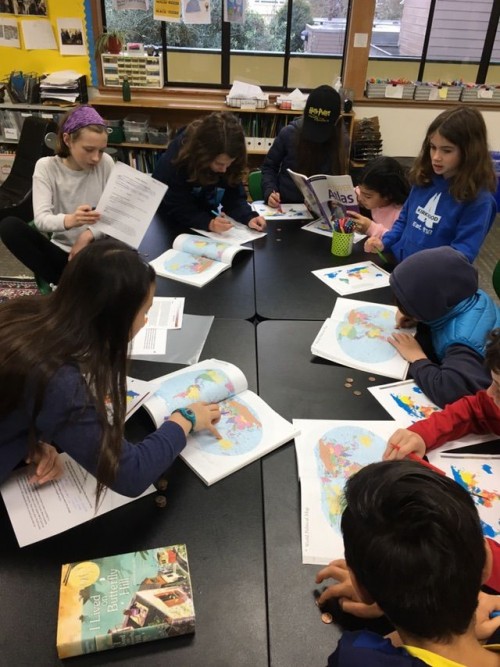5th Grade Refugee Unit Builds Intercultural Understanding & Compassion
Tagged with:
By Talia Goodkin ’98, 5th Grade Humanities Teacher
5th Grade has spent an exciting nine weeks deeply engaged in our interdisciplinary Refugee unit! By reading refugee stories, watching videos, reading articles, taking part in simulations, and ultimately researching a specific refugee story, students have begun to understand how people are displaced and the dilemmas that we, as people in a global society, must confront.
As part of this unit, we started by learning a little about United States immigration history and how attitudes have changed at different points in time, examining political cartoons and making our own American policy timelines before focusing our attention on some essential questions:
- Who can become a refugee?
- Who should take care of refugees?
- Why are some governments and people reluctant to help refugees?
- Which countries are accepting refugees and which ones are not?
- Why do refugee camps exist?
- What are the differences between a refugee, an asylum-seeker, and a migrant?
We introduced six different novels featuring refugee stories, and students led their own book clubs centering around each one. The novels portray a range of experiences and places in the world, from Sudan (A Long Walk to Water) and Somalia (Kiki and Jacques), to El Salvador (Journey of the Sparrows) and Chile (I Lived on Butterfly Hill), to Vietnam (Listen, Slowly).

We worked with multiple guest teachers and speakers throughout the unit, including David Panilla-Muñoz, a social worker for the International Red Cross in Bilbao, Spain who Skyped with us about his work resettling refugees; immigration attorneys Tina Reggio and SFS parent Caroline Donahue who came in to speak with the 5th Graders about their work; Kathryn Clark, SFS parent and textile artist who created a textile representation of Syrian refugee journeys; and graphic facilitator Rio Holiday, former refugee resettlement agency worker, who led the class through an exercise to to imagine what one might feel, want, or need after moving to a brand new country. She recorded their conversations and invited kids to try their hand at telling stories in pictures!



The 5th Graders were put into “family” groups for a series of simulations based on curriculum from the UNHCR, the United Nations Refugee Agency. They took on different roles and were given scenarios around their family’s refugee stories, eventually doing 8 different simulations of experiences refugees go through. After each simulation, they wrote diary entries from their characters’ points of view. As a final project, they created a scrapbook of each family’s diary entries, artifacts from their journeys, photos, etc.


They then paired up for research projects, reviewing traits of nonfiction texts, studying real stories of refugees from one of 11 countries with larger refugee populations (Afghanistan, Yemen, Guatemala, Iraq, Bhutan, Nigeria, Ukraine, Congo, El Salvador, South Sudan, and Myanmar), and then putting together an informational poster with a nonfiction essay about the country they studied.

Individually, the 5th Graders created a portfolio of their learning from the unit, comprised of four different writing pieces, including a poem from the point of view of a refugee:

The last component of our project, in addition to sharing our work with 5th Grade families, will be a student-led school supplies drive for refugees, through Jewish Family & Community Services of the East Bay. Stay tuned to find out how you can get involved!
Posted March 12, 2019

